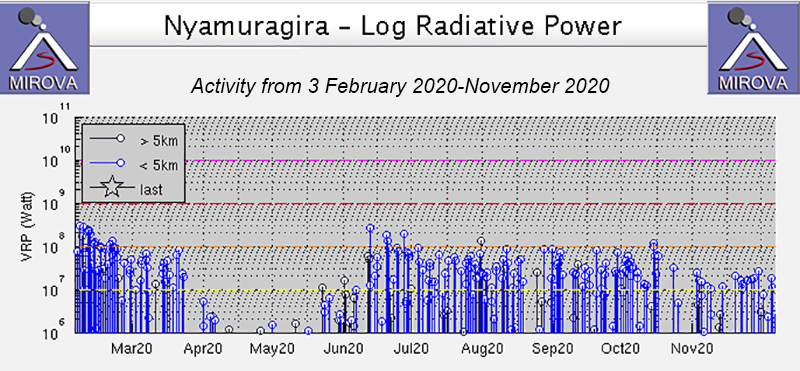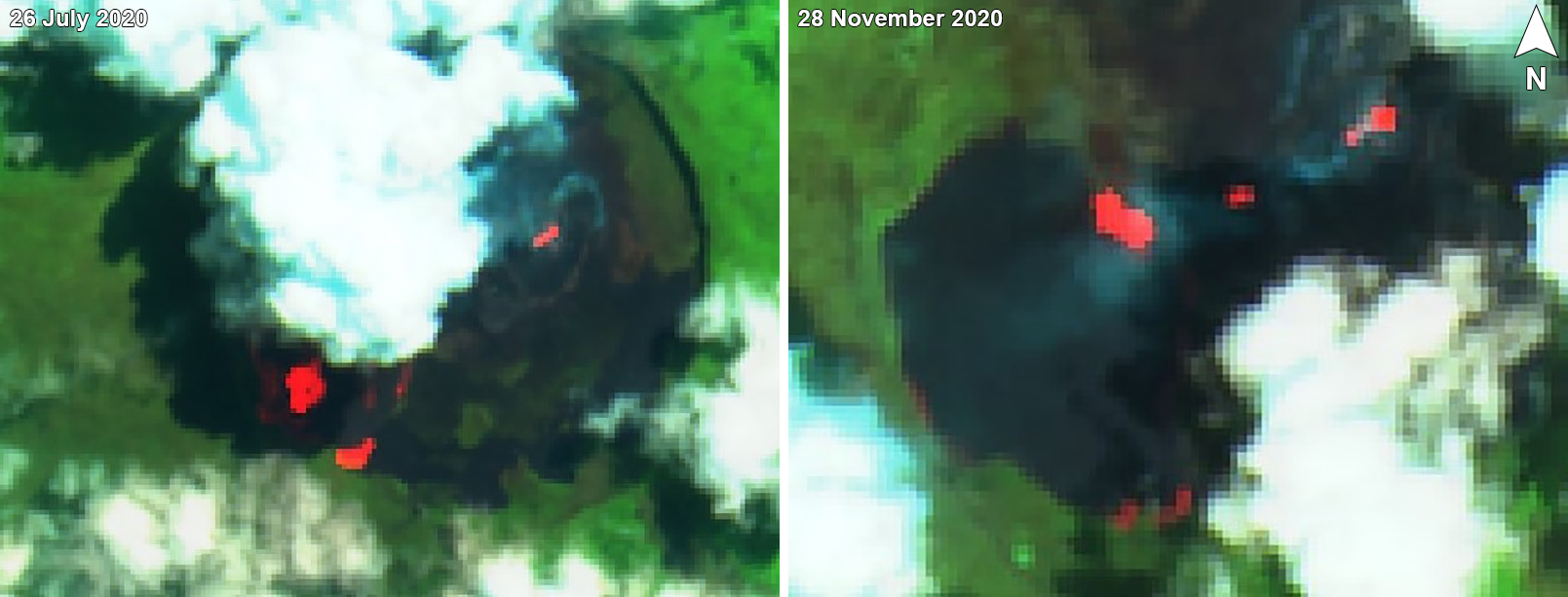Report on Nyamulagira (DR Congo) — December 2020
Bulletin of the Global Volcanism Network, vol. 45, no. 12 (December 2020)
Managing Editor: Edward Venzke.
Research and preparation by Paul Berger.
Nyamulagira (DR Congo) Numerous thermal anomalies and gas emissions from the lava lake through November 2020
Please cite this report as:
Global Volcanism Program, 2020. Report on Nyamulagira (DR Congo) (Venzke, E., ed.). Bulletin of the Global Volcanism Network, 45:12. Smithsonian Institution. https://doi.org/10.5479/si.GVP.BGVN202012-223020
Nyamulagira
DR Congo
1.408°S, 29.2°E; summit elev. 3058 m
All times are local (unless otherwise noted)
Nyamuragira (also known as Nyamulagira) is a shield volcano in the Democratic Republic of the Congo with a 2 x 2.3 km caldera at the summit. A summit crater lies in the NE part of the caldera. In the recent past, the volcano has been characterized by intra-caldera lava flows, lava emissions from its lava lake, thermal anomalies, gas-and-steam emissions, and moderate seismicity (BGVN 44:12, 45:06). This report reviews activity during June-November 2020, based on satellite data.
MIROVA (Middle InfraRed Observation of Volcanic Activity) analysis of MODIS satellite data showed numerous thermal anomalies associated with the volcano during June-November 2020, although some decrease was noted during the last half of August and between mid-October to mid-November (figure 84). Between six and seven thermal hotspots per month were identified by MODVOLC during June-November 2020, with as many as 4 pixels on 11 August. In the MODVOLC system, two main hotspot groupings are visible, the largest being at the summit crater, on the E side of the caldera.
Sentinel-2 satellite images showed several hotspots in the summit crater throughout the reporting period (figure 85). By 26 July and thereafter, hotspots were also visible in the SW portion of the caldera, and perhaps just outside the SW caldera rim. Gas-and-steam emissions from the lava lake were also visible throughout the period.
Geological Summary. Africa's most active volcano, Nyamulagira (also known as Nyamuragira), is a massive high-potassium basaltic shield about 25 km N of Lake Kivu and 13 km NNW of the steep-sided Nyiragongo volcano. The summit is truncated by a small 2 x 2.3 km caldera that has walls up to about 100 m high. Documented eruptions have occurred within the summit caldera, as well as from the numerous flank fissures and cinder cones. A lava lake in the summit crater, active since at least 1921, drained in 1938, at the time of a major flank eruption. Recent lava flows extend down the flanks more than 30 km from the summit as far as Lake Kivu; extensive lava flows from this volcano have covered 1,500 km2 of the western branch of the East African Rift.
Information Contacts: Observatoire Volcanologique de Goma (OVG), Departement de Geophysique, Centre de Recherche en Sciences Naturelles, Lwiro, D.S. Bukavu, DR Congo; MIROVA (Middle InfraRed Observation of Volcanic Activity), a collaborative project between the Universities of Turin and Florence (Italy) supported by the Centre for Volcanic Risk of the Italian Civil Protection Department (URL: http://www.mirovaweb.it/); Hawai'i Institute of Geophysics and Planetology (HIGP) - MODVOLC Thermal Alerts System, School of Ocean and Earth Science and Technology (SOEST), Univ. of Hawai'i, 2525 Correa Road, Honolulu, HI 96822, USA (URL: http://modis.higp.hawaii.edu/); Sentinel Hub Playground (URL: https://www.sentinel-hub.com/exp).



